Menu
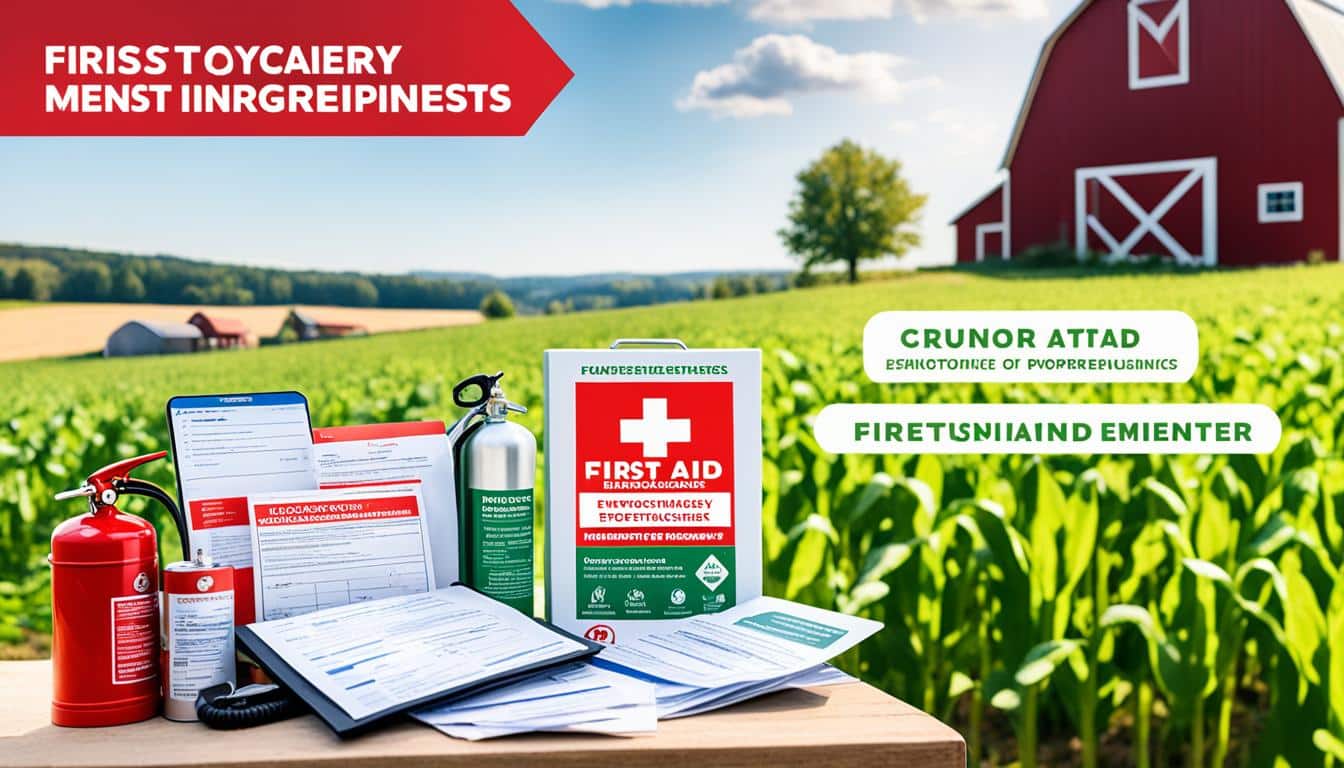
Did you know that 90% of farms don’t have enough insurance to protect their stuff? This fact shows how important insurance is. It’s key for safety and dealing with crises on the farm. Today, farmers risk losing a lot from driving on roads to roofs collapsing.
Farmers often find insurance hard to understand. This makes them open to risk. Experts say farmers should work with insurance pros. And, they should check their policies often, especially the limits. This ensures they’re covered when disasters strike.
When you get farm insurance, you’ll see different parts like Declaration Page or Definitions. It also includes Exclusions and Conditions. Knowing these helps. You can add special needs to your policy with endorsements. This makes your farm safer.
Agriculture insurance is crucial. It covers many risks like losing property or facing a lawsuit. It protects your home, farm stuff, and buildings. You may need extra policies for vehicles or worker insurance. And, you can adjust a policy with endorsements for better fit.
Farm insurance is a legal deal that protects a farmer from different kinds of harm or loss. It’s important for farmers to know what this insurance has and how it works. This knowledge helps them keep their farm safe and well-managed.
Farm insurance is like a promise from the insurance company to help the farmer if something bad happens. It’s very important for farmers because they deal with many risks every day. Knowing what these policies do means farmers can look after their farm and their families well.
There are lots of different farm insurance plans, each for different farming needs. There’s coverage for things like liability, and for the farm’s buildings and their personal possessions. There are even special plans to help with unique farm tasks. Choosing the right mix of these plans is key to protecting against unexpected losses.
Agriculture is full of risks. Natural events like droughts and storms, market changes, and new laws all make farming risky. That’s why it’s so important to assess farm risks and manage hazards well.
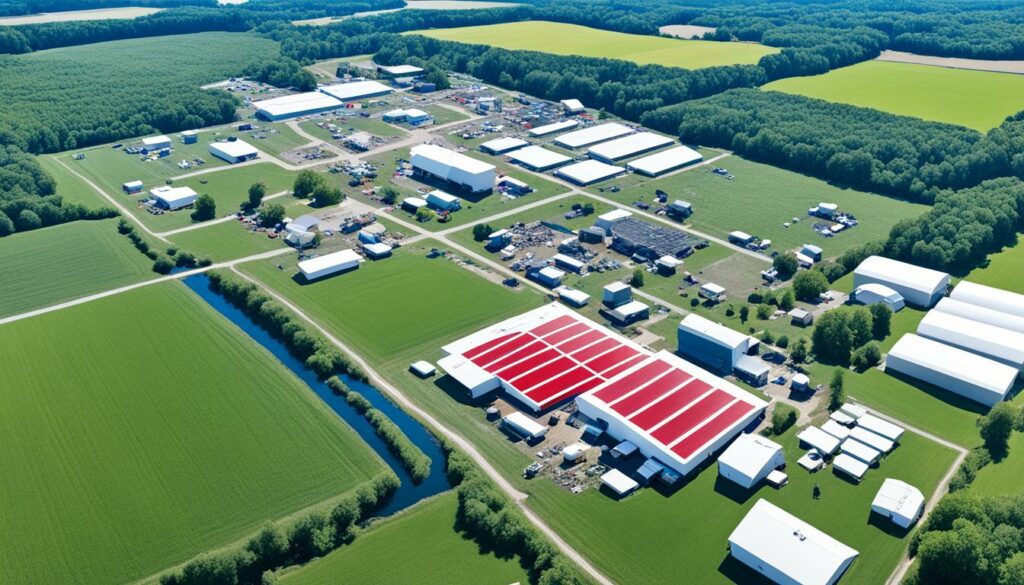
Natural disasters can hit farms hard. They include floods, hurricanes, and wildfires. These disasters can cause big losses in production and income. FEMA advises getting more insurance to protect against such events.
“The Colorado State University Extension provides factsheets on caring for livestock before, during, and after disaster situations.”
Disasters are happening more often and worse because of climate change. This puts farming and rural communities at risk. Farms need good plans to handle these risks. For example, the Louisiana State University Ag Center offers help for livestock producers to prepare.
The AVMA gives out a detailed disaster checklist that’s 16 pages long. It talks about protecting animals and people. It highlights the dangers like diseases and poisonings from disasters. It also talks about the importance of disaster planning for health.
Having an emergency plan is key to save lives during disasters. Working with local emergency services is a must. People in rural areas should also have their own plans. This should include food, medicine, and important papers.
“Engaging the community post-disaster can aid in faster recovery and build resilience.”
Knowing the local land well helps to predict and prevent disasters. But, rural areas struggle more in recovering from disasters. They have less help and fewer resources. Good risk assessment and management can help farming communities be stronger.
It’s key for farmers to know the parts of their insurance policy. Each one spells out what it covers, what it doesn’t, and other important details. This helps farmers get the protection they need for their business.
The declaration page gives a quick look at the whole policy. It features the farm covered, the insurance period, and what’s protected. It also shows deductibles and limits. This section helps farmers see exactly what their policy protects.
This part outlines what the insurance company promises to do. It covers the risks and services for claims. The insuring agreement explains when and how the insurance will help.
Knowing what the policy doesn’t cover is as important as knowing what it does. Exclusions list what’s not included, like certain events or damage types. Knowing these helps prevent surprises during claims. It also reminds to add extra coverage if needed. For example, some policies don’t cover war damages or intentional harm.
For farmers in areas with specific risks, like Minnesota, extra caution is needed. They should check if their policy includes threats such as tornadoes and heavy snow. Discussing their needs with an expert can help find and fix any gaps in coverage.
| Component | Description |
|---|---|
| Declaration Page | Identifies insured parties, policy period, deductibles, and policy limits. |
| Insuring Agreement | Defines covered perils and services provided by the insurer. |
| Policy Exclusions | Lists events, property types, and causes of loss not covered by the policy. |
Farming faces many risks that can lead to legal issues and loss. So, having the right insurance is key. This insurance helps cover costs from legal claims, keeping your business safe.
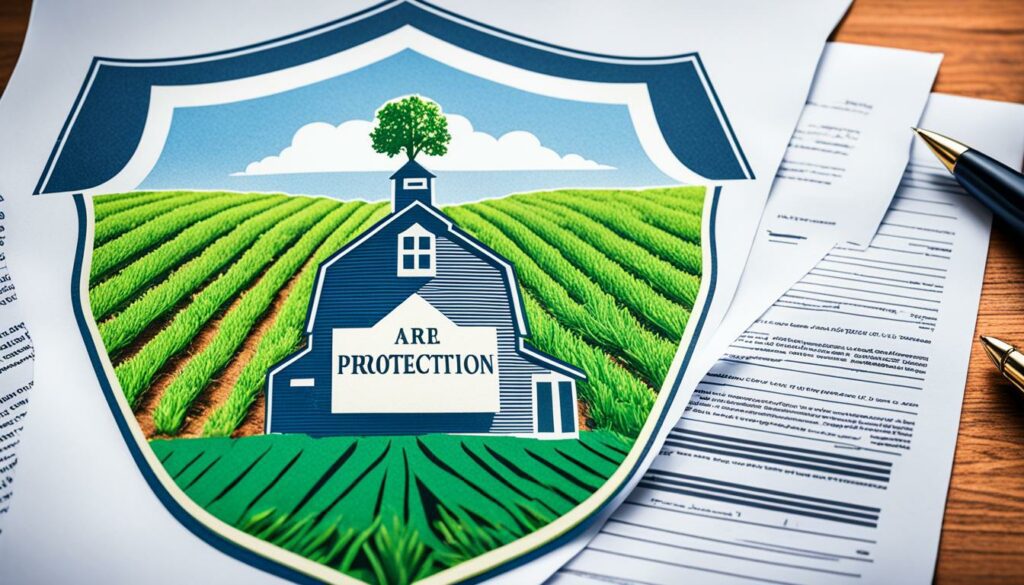
Liability insurance is crucial for any farm. It covers costs from injuries, property damage, and medical bills. By having this protection, your farm is safe from unexpected costs like a barn roof collapsing.
On a farm, many situations can lead to liability issues. This might include accidents with equipment or injuries to visitors. Having the right insurance ensures you’re protected from these possible lawsuits.
Farm insurance usually covers a lot of bases. It includes important sections like the Declaration Page and Exclusions. You can also make changes with endorsements to meet your specific needs.
Having property loss coverage is key for farm asset protection. It gives financial safety if something bad happens to your farm. This includes your important equipment, animals, and buildings like barns.
It’s important to know about property damage insurance. The Emergency Conservation Program (ECP) helps fix and replace farm stuff after natural disasters. If too many animals die because of bad weather, the Livestock Indemnity Program (LIP) can help. For farmers facing disease or severe weather losses, the Emergency Assistance for Livestock, Honeybees, and Farm-raised Fish Program (ELAP) provides aid.
It’s vital to understand what dangers are covered in your insurance. Things like drought for livestock or contamination for dairy are considered. The Farm Storage Facility Loans (FSFL) can cover up to $500,000 in damages. This shows how much you can protect your farm from financial harm.
Securing property loss coverage is a smart move. It means your farming business is safe from unexpected disasters. With the right insurance, you protect every part of your farm. This way, your farming can stay strong and grow.
Farmers need to protect their crops from risks to ensure a steady food supply. 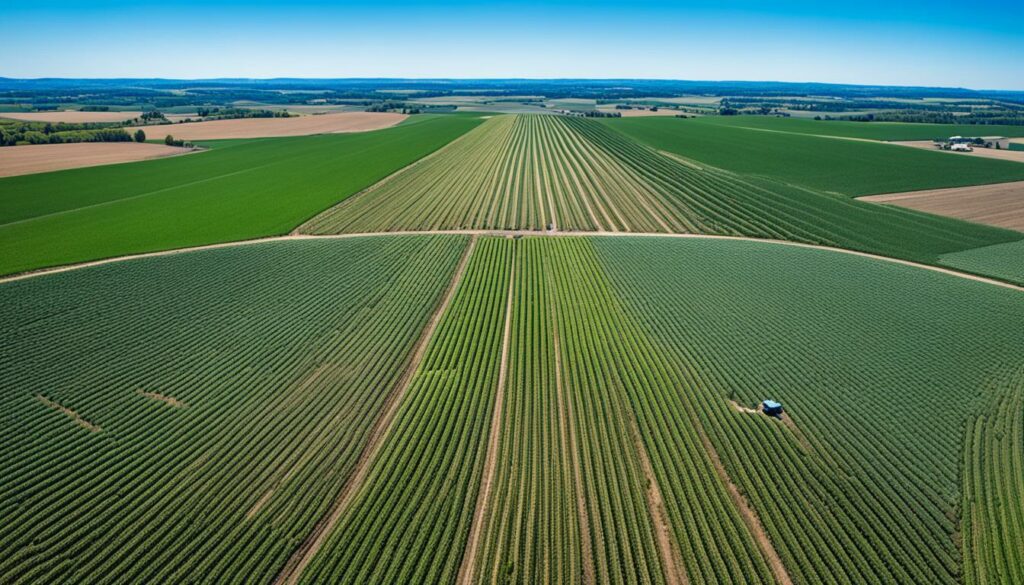
The Federal Crop Insurance Program (FCIP) in the U.S. is a big help. It covers many crops and parts of farming. By working together with private companies, it makes insurance affordable. The FCIP offers over 130 different insurance plans. This shows how it meets the changing needs of farmers over time.
One good example is the wind insurance it started in 2020. It protected farmers from wind damages that year. This special insurance helps when new kinds of risks appear.
| Program | Coverage Details | Benefits |
|---|---|---|
| Livestock Indemnity Program (LIP) | Covers livestock deaths due to adverse weather, disease, or animal attacks | Provides financial support for losses exceeding normal mortality |
| Tree Assistance Program (TAP) | Assists in replanting or rehabilitating eligible trees, bushes, and vines | Helps orchardists and nursery growers recover from natural disasters |
| Livestock Forage Disaster Program (LFP) | Compensates for grazing losses on native or improved pastureland | Supports producers during drought conditions or fires on federally-managed land |
| Conservation Reserve Program (CRP) | Contracts to remove environmentally sensitive land from production | Improves environmental health through long-term agreements |
| Environmental Quality Incentives Program (EQIP) | Provides financial resources and planning assistance | Helps with disaster recovery and long-term land improvement |
There are different types of crop insurance for farmers, each with its focus. These are:
States like Iowa, Indiana, and Illinois have their own programs to lower costs for farmers. This encourages more farmers to get insured against risks.
Farm insurance works well because the money collected usually matches the money spent to help farmers. This balance is very important for keeping insurance working well for all.
Adding insurance to a farm’s emergency plan is really important. Doing this helps protect farms from unexpected problems. About 59% of disasters are natural, like tornadoes, hurricanes, and floods. The other 41% are disasters people cause, such as explosions. In farming, most emergencies come from equipment breaking, like PTO shafts. Only a third are from things like extreme weather.
Good agriculture contingency planning includes having solid insurance. This lessens the money problems these emergencies can cause. For instance, farms with good plans can cut their damage risks by 80%. Also, having a plan for moving livestock and enough emergency goods means 60% fewer losses in a crisis.
Planning for risks actively means doing drills and making sure everyone knows what to do. Studies show that drills make farms 50% better at handling emergencies. Clearly laying out who does what in an emergency reduces chaos by 40%. This helps get quick, smooth reactions.
There are programs that help farms deal with disasters, like the Tree Assistance Program (TAP). It helps replace or fix trees for people who grow fruits. There’s also the Emergency Assistance Program (ELAP). It gives money for lost livestock or crops because of bad weather or disease.
Having insurance is vital in full farm protection against emergencies. It makes sure farms can bounce back and keep running after crises. By making insurance part of the farm’s emergency plan, a farm can be stronger and stay in business, despite harsh farming risks.
Farm insurance policies have many parts to cover the risks of farming. To match their specific needs, farmers can use special coverage options and policy endorsements. This helps them get the exact protection they need against financial loss.
Endorsements tweak standard insurance policies to fit unique farm situations better. For example, they can change liability limits for activities like agri-tourism. This means farmers are better protected from legal claims while interacting with the public on their farm.
Such policy tweaks are vital. They ensure farmers get the right kind of coverage that regular policies might miss.
Farm machinery is critical for a farm’s work. It faces risks like breakdowns and accidents. Machinery insurance steps in to pay for repairs or give new equipment.
This tailored insurance keeps farmers working without sudden financial worries.
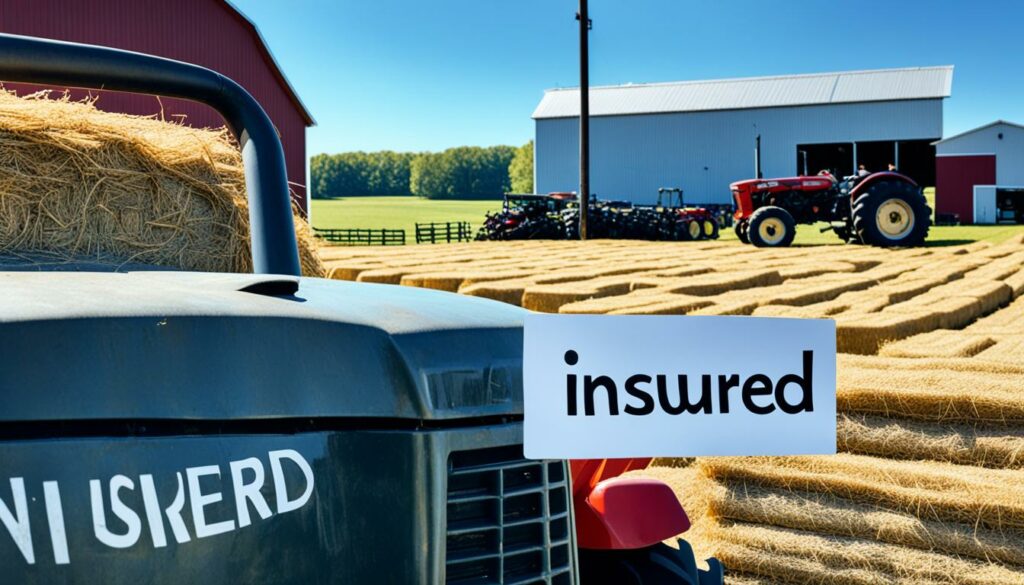
Adding endorsements and machinery insurance helps farmers deal with particular risks. It’s important to fully understand these parts of the policy. Doing so makes sure the farm is ready to face any challenge.
Insurance for weather extremes keeps farming strong, even when the weather is tough. After all, heatwaves that last over 3 days at 90°F hurt farmers a lot. So, insurance really helps protect farms from the ups and downs of weather.
The USDA Farm Service Agency (FSA) does a lot to help both insured and uninsured farmers. They have big plans to help out, like:
Also, there’s help from the Livestock Indemnity Program (LIP) for those hit hard by weather. FEMA joins in too, with aid for individuals and whole communities, making farms stronger against climate challenges.
Emergency Milk Dumping Surveys give needed info on how disasters affect farming. This data shows why quick recovery help is so important.
The USDA Risk Management Agency spreads their help with special crop insurances in every county. For example, Whole Farm Revenue insurance covers lots of crops under one policy, protecting farmers better.
Noninsured Crop Disaster Assistance is there too, offering help for bad crop years caused by disasters. It’s an extra line of defence for farmers with crops that can’t be insured.
Table detailing federal programmes and their benefits:
| Programme | Coverage | Benefits |
|---|---|---|
| ELAP | Livestock, Honey Bees, Farm-raised Fish | Financial aid for adverse weather & other conditions |
| LFP | Livestock grazing losses | Up to $125,000 for drought/grazing losses |
| NAP | Non-insurable crops | Aid for various natural disasters |
Overall, these insurance and support programmes are key for farming’s climate resilience. They help financially protect farms from weather challenges, ensuring a stable and sustainable future for agriculture.
Farmers need a solid farm emergency action plan for crisis response. There are many potential hazards on a farm. So, it’s vital to have a detailed strategy for different emergencies.
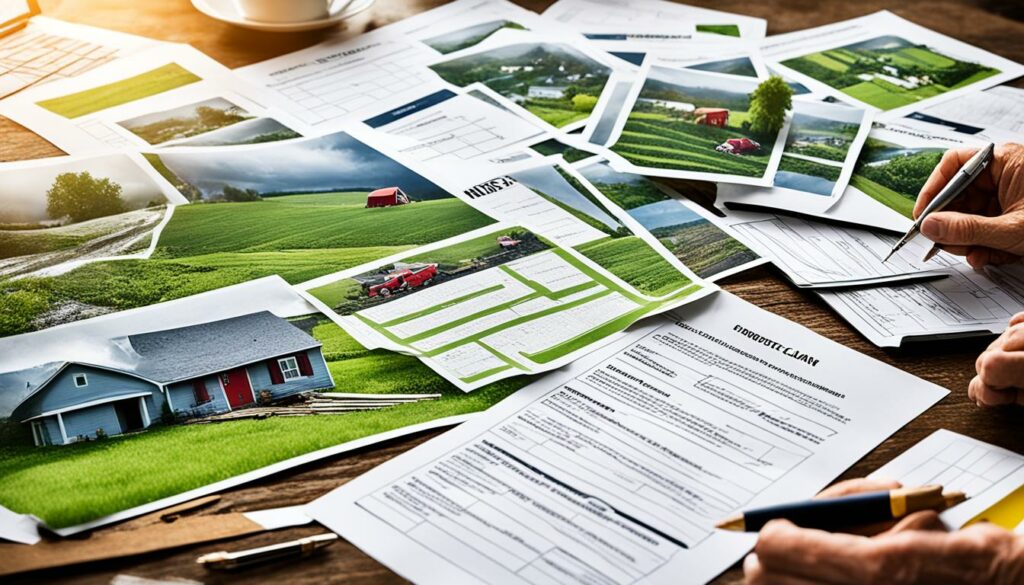
Creating a farm crisis plan means looking at all risks and setting clear steps for emergencies. Not many farms have fully detailed emergency plans. To be better prepared, farmers should draw maps of their farms, showing roads and where their animals are. They should also spot where to move important things to during a crisis.
It’s important to keep emergency contacts and review tools, fire extinguishers, and generators often. Being ready for emergencies helps reduce problems and keeps families and animals safe.
| Aspect | Percentage of Farms |
|---|---|
| Comprehensive Emergency Plans | 45% |
| Evacuation Locations for Livestock | 35% |
| Emergency Supply Kits | 50% |
| Regular Plan Review | 20% |
Insurance is vital for a farm’s crisis readiness. It gives financial support in emergencies. The data shows many farms don’t have the right insurance for all risks.
Keeping insurance updated with experts helps protect farm tools, animals, and buildings. This is key in a farm’s emergency plan, making it easier to start again after an emergency.
Thanks to groups like the Multi-State Partnership for Security in Agriculture, farmers are learning to keep emergency contacts handy. This includes numbers for police and fire services. With good insurance and education, farms can face surprises well.
Agribusinesses are going beyond the norm, stepping into agri-tourism and large-scale farming. This shift makes having the right insurance a must. They face more risks now than just those in the fields.
Hosting people at a farm comes with its own set of risks. This includes farm-stays, petting zoos, and tours. There’s a possibility of minor incidents like falls or more serious ones with animals. It’s vital to manage these risks well. The proper insurance covers everything, making sure your business is safe from big losses.
Commercial farms now do more than grow crops. They have processing plants and other big operations. This means they need insurance that protects everything. There’s even a loan program for better storage facilities. It helps protect valuable crops better.
There are also special programs for livestock and emergency relief. These show how insurance needs to change with farming. As farming gets more advanced, so should the insurance. This way, farms can stay strong through any challenge.
Rural catastrophe insurance is key for farms facing sudden disasters. This coverage acts as an essential farm safety net. It helps protect the money farms earn when disaster hits. For example, the Tree Assistance Program (TAP) helps by giving funds to replant or fix trees damaged by disasters. This shows the importance of having help ready when it’s needed most.
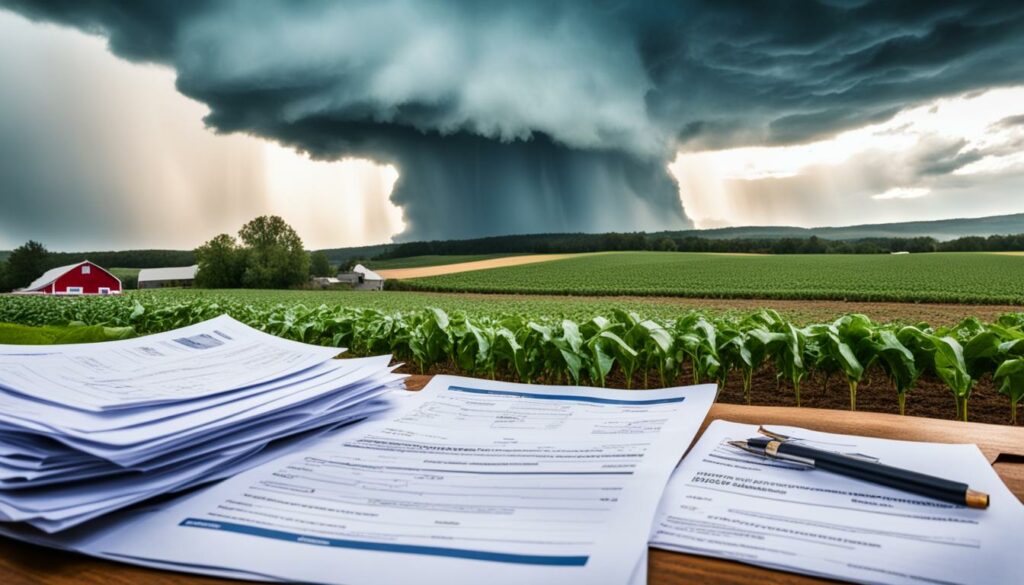
The Livestock Indemnity Program (LIP) plays a big role in helping farms. It provides emergency financial support for farms when they have livestock loss. This loss might be due to bad weather or health issues.
Also, it helps farmers repair their land and save water in droughts with the Emergency Conservation Program (ECP).
The Dairy Indemnity Payment Program (DIPP) helps dairy farmers too. If something like pesticides makes milk unsafe, it steps in to help. This support is vital, underlining how essential farm safety nets are for our farming areas.
The Environmental Quality Incentives Program (EQIP) is about land and water care. It helps with land fixes after fires and protects vital water sources. Such steps are part of ensuring farms can keep going in tough times.
| Program | Description |
|---|---|
| Emergency Loan Program | Provides financial aid to producers for recovering from production losses due to natural disasters or quarantine situations |
| Disaster Set-Aside Program | Allows producers with existing direct loans to temporarily halt scheduled payments after a designated natural disaster |
| Emergency Relief Program | Funded agricultural producers affected by natural disasters in 2020 and 2021 |
| Agricultural Conservation Easement Program (ACEP) | Offers management options for wetland reserve easements, allowing for haying or grazing aligned with wildlife habitat conservation |
| Livestock Forage Disaster Program (LFP) | Compensates for grazing losses due to drought conditions or fires on federally managed land |
Insurance for farm emergency preparedness is vital in today’s agriculture. Farmers need strong insurance plans to deal with natural and man-made disasters. This protection includes tornadoes, floods, and chemical spills.
Farmers must be prepared to handle these risks. Good emergency insurance policies for agriculture help farmers recover. They provide financial help and support to get the farm up and running again.
Staying ready for emergencies is key. This means keeping an eye on alerts, having emergency kits, and knowing what’s on your farm. It’s also important to make sure your workers know what to do. Planning with local emergency teams and having supplies ready can save lives.
It’s also vital for everyone to know their jobs on the farm. Having maps that show escape routes and where to meet up is smart. Keeping an updated list of emergency contacts and practicing for disasters with drills is essential. These actions make a big difference when something goes wrong.
Insurance can fit a farm’s unique needs. It might include self-insurance or plans with high deductibles. Assurex Global is a top group that can help farms all over the world. They support farms to reduce the effects of emergencies.
| Trigger | Type of Insurance | Coverage Focus |
|---|---|---|
| Natural Disasters | Property Insurance | Damage to structures, equipment, and inventory |
| Man-made Incidents | Liability Insurance | Third-party injuries and property damage |
| Employee Injuries | Worker’s Compensation | Medical expenses and wage replacement |
| Operational Interruptions | Business Interruption Insurance | Loss of income during the recovery period |
In short, good insurance for farm emergency preparedness is vital. For today’s farmers, having the right emergency insurance policies for agriculture is a must. These plans give farms the financial help they need in a crisis. This peace of mind is priceless.
It’s vital to understand and apply different farm insurance options for strong emergency readiness. The Colorado Department of Agriculture’s (CDA) new emergency management effort shows how important it is to be ready and have plans that fit farms. A good insurance plan helps farms deal with and bounce back from many dangers and risks.
Making sure records are kept well is crucial, says CropTracker. This includes details about animals and farm workings. Moving from paper to digital keeps these records safe and easy to use in emergencies.
Insurance is key for lessening disaster impacts, meeting the National Preparedness Goal of a safe and strong nation. For livestock, insurance helps during tough times by dealing with health problems, moving animals out, and getting rid of dead animals when disasters happen, like floods or diseases. Working together, local, state, and federal groups can keep the food supply and market going.
Being proactive in getting the right insurance is crucial. Farmers should often check and update their plans to cover any new risks. Doing this helps them stay ready for emergencies, keeping their farm and income safe.
Insurance is key in getting ready for emergencies on the farm. It means the farm can keep going even when hit by risks like natural disasters.
Farm insurance is like a safety net. It protects a farm against financial losses from various damages. This includes things like operations, crops, and the land itself.
There are different types of farm insurance. They cover things like liability, losses to properties, crops, and special needs of farms, such as agri-tourism.
Agriculture has its own set of risks. These involve weather, market changes, and legal rules changing. These can greatly affect the farm’s income and future.
A farm insurance policy includes several key parts. It starts with a declaration page, then details coverage agreements, and what isn’t covered. This helps farmers know exactly what they’re protected from.
Liability insurance is very important for farmers. It protects them from risks tied to accidents or damage to people’s property. It also covers the legal costs of defending against claims.
Farmers need liability insurance for many things. This includes accidents with machinery, injuries from agri-tourism, and damage by livestock. Good coverage helps deal with these problems.
Property loss coverage guards the farm’s assets. It helps recover costs from damage or loss by covered perils. This includes machinery, livestock, and buildings like barns.
The FCIP is crucial in crop insurance. It covers various crops and types of protection. These policies defend against issues with yield, quality, and weather.
Crop insurance is vital in guarding against events that reduce crop production. It keeps farmers financially secure from weather, disease, and other surprises.
Insurance is a big part in preparing for emergencies on the farm. It provides financial help and support after disasters. This makes sure the farm can keep running.
With endorsements, farmers can customise their insurance. They can add more liability for things like agri-tourism or protect machinery. This gives them a broader safety net.
Weather insurance is key because climate can greatly affect farming. It helps financially with damage from hail, drought, or floods. This builds up the strength of agriculture.
Farmers need a detailed crisis plan. It should include steps for emergencies and their insurance policies. This ensures smooth recovery and less disruption.
Agribusiness insurance has to cover a wide range of risks. It should look beyond usual farming risks to also protect from agri-tourism and commercial concerns. This makes sure the coverage grows with the farm’s activities.
Rural emergency insurance offers a financial lifeline in disasters. It helps lessen the blow of a crisis on farms and in the countryside. It protects farmers’ incomes and their way of life.